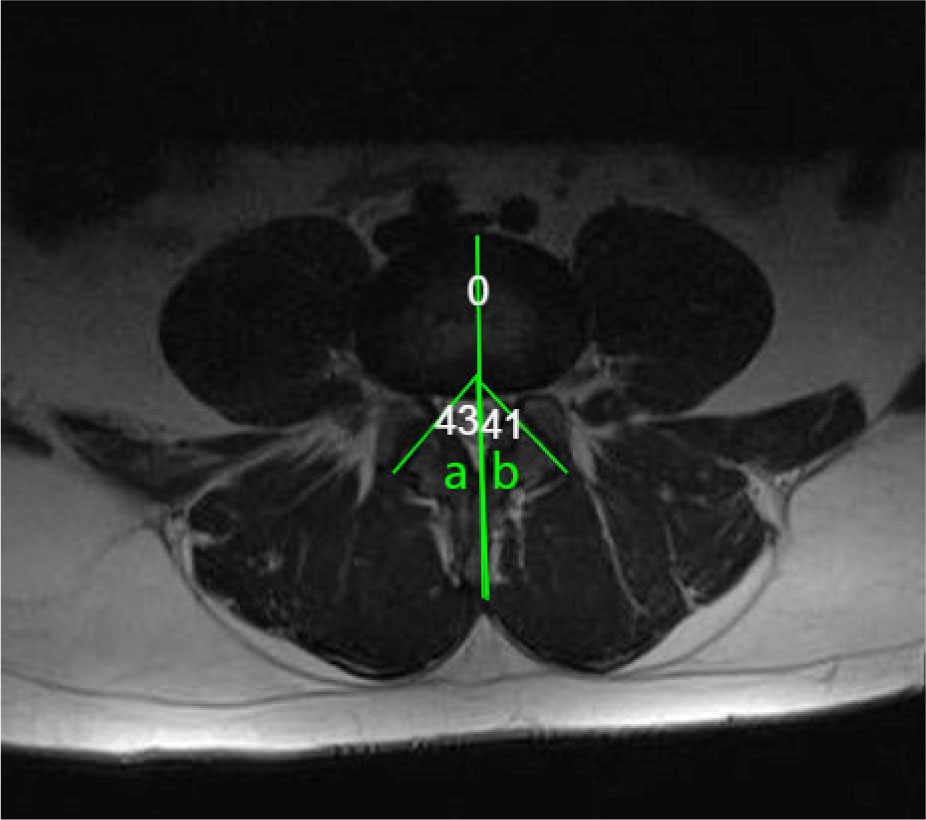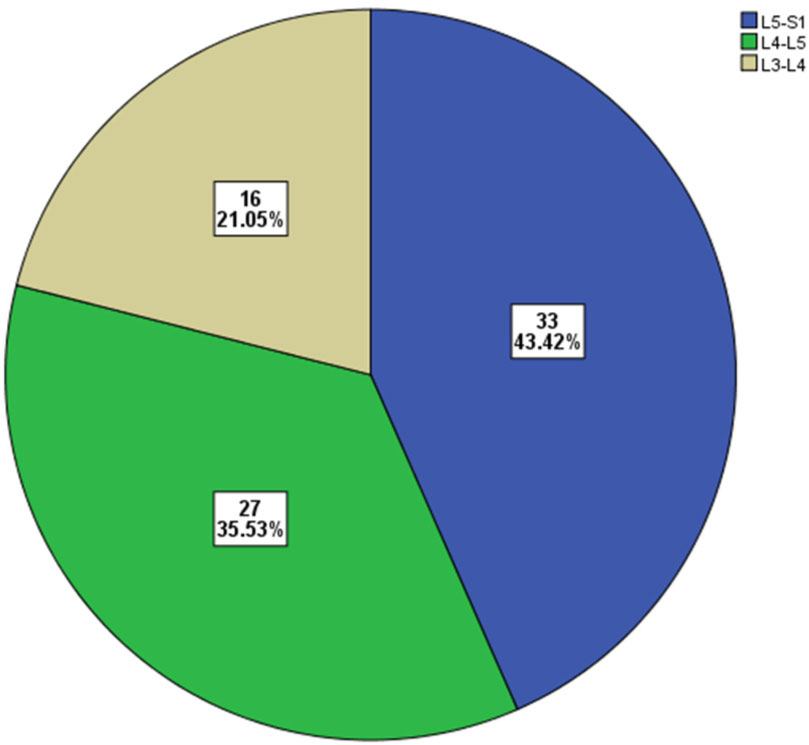1.
Introduction
Intervertebral disc herniation is known as the most common skeletal system pathology causing low back pain [1]. This degenerative disc pathology can progress due to its inherent biologic properties and improper mechanical movement. Condition caused by this pathology is the most common reason for absence from work and is considered a general health issue all over the world [2]–[4]. Disc herniation occurs in any age group, but it is more likely to occur in ages 40–50. It is estimated that around 2–3% of population (about 5% of men and 2.5% of women) are affected by this disease [5]. Studies have suggested that its etiology involves multiple factors associated with everyday life habits such as heavy lifting, smoking, obesity, and also normal aging process, genetic, and anatomical changes [6].
Facet orientation is an important structural factor in disc degenerative disease. Facet joints are placed on a transverse plane proportional to sagittal plane. Facet tropism (FT) is defined as an asymmetric angular orientation of left and right facet joints. FT has the potential to make biomechanical changes in lumbar movements which in turn accelerate the degenerative changes in adjacent intervertebral discs or joints [7]–[9]. First theory belongs to Farfan et al. which indicated a relationship between FT and progression of intervertebral lumbar disc herniation. FT > 10 degrees was detected in 14–28 percent of cases. Studies have shown that FT was associated with increased shear forces and hence decreased resistance to shear forces [10]–[12].
Despite the previous efforts made to study whether facet orientation and tropism increase the risk of lumbar disc herniation, the results are still inconsistent. Some studies demonstrated the relationship between FT and lumbar disc herniation [10],[12]–[18], while others have found no relationship [19]–[24]. Therefore, clinical significance of FT and its orientation are still unidentified. In this study, we aim to investigate the relationship between facet tropism and lumbar discs herniation at L3–L4, L4–L5, and L5–S1.
2.
Method
2.1. Patients
The present study is a comparative, cross-sectional study. Patients referring to radiology department of Poursina Hospital in 2017–2018 with low back pain and lumbar disc herniation only in one intervertebral level (L3–L4, L4–L5 or L5–S1) entered the study voluntarily with gradual sampling method, then they were divided into case and control groups accordingly. patients with disc herniation in a given lumbar level were considered as case group and control group was defined as patients without signs of disc herniation. Lumbar disc herniation in all patients was evaluated and diagnosed by only one expert radiologist.
2.2. MRI and measuring method
In recent years MRI is the most common modality to assess patients with spinal degenerative diseases. In this study, 1T conventional MRI was used for scans of L1–S1 levels with 3 mm slice thickness and 5 mm slice gap on transverse and sagittal planes. In order to perform scans on patients, they were placed in a supine position. Intravenous anesthetic were used for patient who could not tolerate the position due to the pain they were experiencing. Patients with improper MRIs due to rotation, prior surgery or scoliosis were excluded.
Focusing on obtained Axial images, the clearest images with best subjective view of both facet joints without rotation, or technical artifacts were selected. Facet angles were measured by drawing straight lines, one passing through central point of vertebral body and tip of the spinal process, and the others parallel to midline of facet joints. Consistent with Gao et. al. work, facet angles difference equal to or higher than 10 degrees in lumbar vertebrae {a–b} were considered as facet tropism (Figure 1) [25].
2.3. Statisical analysis
After collecting through check-list, data were analyzed with SPSS software, version 21 (IBM Corporation, New York, USA). Quantitative data were compared using Student T-test (independent samples). Qualitative data (categorical) were analyzed by Contingency tables using Chi-Square test and/or Fisher's Exact test based on the situation. In all studied cases, results were considered statistically significant providing their P value was ≤ 0.05.
3.
Results
In this study, 76 patients with lumbar disc herniation in one of intervertebral levels (L3–L4, L4–L5, and L5–S1) were investigated. Men consisted 39.5% (30 individuals) and women consisted 60.5% (46 individuals) of the population. Patients were between the ages 20–97 with mean and standard deviation 46.1 ± 15.3.
In most cases, L5–S1 vertebrae level was involved (43.4%, n = 33). L4–L5 and L3–L4 vertebrae levels were involved in the second place (35.5%, n = 27; 21.1% and n = 16 respectively) (Figure 2).
Each intervertebral level (L3–L4, L4–L5 and L5–S1) was evaluated separately to detect facet tropism. The result of studying L3–L4 level in patients with herniation showed that facet tropism percentage was 43.8% (n = 7), while it was18.3% (n = 11) in control group. This 25% difference was statistically significant according to Fisher's Exact test (P = 0.041) (Table 1).
Evaluating tropism in L4–L5 intervertebral level in patients with herniation showed that the frequency of facet tropism in this level, both in case and control group was less than in L3–L4 level; in other words, it was 37% in case group (n = 10) and 10.2% (n = 5) in control group. However, this difference was statistically significant based on Chi-square test (P = 0.005) (Table 1).
Finally, facet tropism was investigated in L5–S1 intervertebral level in case and control group and its frequency was 48.5% (n = 16) and 27.9% (n = 12), respectively. Although the highest frequency rate of facet tropism was observed in this level, both in case and control group, its difference was not significant based on Chi-square test (P = 0.065) (Table 1).
The frequency of facet tropism incidence is evaluated based on gender, and the results in Table 2 indicate that the rate of incidence is higher in men than in women (66.7% compared to 52.2%); however, this difference is not statistically significant (P = 0.21).
The age average of patients with and without facet tropism was 47 ± 15.7 and 44.7 ± 14.9 respectively, which was not significant based on Independent test (P = 0.937) (Table 3).
4.
Discussion
Facet joints are responsible for mechanical support of posterior column, movement stability and extension, and support against over contraction of disc. Two facet joints in a level carry the parallel load in normal lumbar spine. Asymmetry in facet joint or FT (facet tropism) in vertebrae can be a potential anatomical risk factor for degenerative changes in spine. Moreover, it is assumed that changes in Facet joint alignment with changes in spine biomechanical pressures can lead to early degeneration and herniation of vertebral discs [26]. The concept of facet joint disease as a reason of low back pain in some patients, was presented by Putty in 1927 for the first time. He demonstrated that orientation of two facet joints in a level can be significantly different in sagittal plane [27]. Using biomechanical studies, some researchers have shown that FT is associated with increased shear pressure and hence increased risk of low back pain. Farfan et al. stated that Facet joint asymmetric orientation can lead to increased shear pressure in axial rotation and hence increased torsion stress in annulus fibrosus [14]. On the other hand, Kim et al. showed that facet orientation does not increase stress in disc or facet joint, but FT can make that part more susceptible to external movement or anterior shear force [11].
In the present study, herniation is more identified in L5–S1 intervertebral level. Tisot et al identified 47.1% of herniation cases at L5–S1 intervertebral level [28]. The frequency of facet tropism incidence was investigated based on gender. the results showed that although the rate was higher in men, the difference was not statistically significant. In a study carried out by Lee et al., the results showed that there was no significant difference in rate of facet tropism incidence and lumbar disk herniation based on sex [8].
The age average among patients with herniation was 46.1 ± 15.3 in this study. Although there was no statistically significant difference in age average of patients with and without facet tropism, patients with facet tropism had higher age average. The result of other studies showed that with aging process, facet tropism was accelerated as a degenerative process. With aging, spine instability developed as a result of undermined facet joints and intervertebral discs; the condition was much severe in some cases that leads to slip of upper vertebra on the lower [15],[29]–[32].
According to the results of this study, there was a statistically significant difference in incidence of facet tropism at L3–L4 level between patients with herniation and control group. The results of studies carried out by Pichaisak et al. [33] and Chadha [13] were consistent with our results. However, in Gao et al., there was no significant difference in rate of facet tropism incidence in L3–L4 level of patient with herniation compared to control group [25]. In addition, the study of facet tropism in L4–L5 intervertebral level showed that the rate of facet tropism in patients with herniation was higher compared to healthy individuals; it was a statistically significant difference [21],[19].
Other findings demonstrate that the highest rate of facet tropism was observed at L5–S1 intervertebral level both in case and control group. Despite the fact that rate of facet tropism incidence in patient with herniation was higher compared to control group, no significant difference was observed. This finding was consistent with Ghandhari et al. as they demonstrated that the rate of facet tropism incidence at L5–S1 intervertebral level in patient with herniation was 50.8% (n = 32) compared to control group which was 36% (n = 22); this was not a statistically significant difference [34]. On the other hand, findings in Gao et al. work was inconsistent with ours; in their study, 24 out of 34 patient with lumbar disc herniation at L5–S1 had facet tropism; while in control group, 10 out of 52 patients had facet tropism which was a statistically significant difference [25].
The results showed that there was a statistically significant relationship between FT and disc herniation at L3–L4 and L4–L5 intervertebral level in case and control groups, while it was not significant at L5–S1. The reason for insignificance at L5–S1 may be the change in the ratio of case to control group compared to two other levels (More number of cases and less number of controls).
Due to the controversy of previous clinical and biomechanical studies, the role that FT plays in lumbar disc herniation remains unknown; it is still unconfirmed that whether FT is associated with increased risk of lumbar disc herniation. These differences can be partly due to differences in measurement of facet angles, differences in FT definitions or research protocols.
Several studies indicated that the presence of FT (11 degrees ≤) was the underlying condition for incidence of lumbar discs herniation, especially in aged people [15],[18]. Kunakornsawat et al. defined FT as 5 degrees difference in angle between right and left facet joints; they found no significant difference between herniation and FT [35]. Karacan et al. introduced FT as difference in two-side angles more than two interobserver errors and found that FT was more common in patients with lumbar disc herniation [36]. Kong et al. defined FT as 7 degrees difference between two-side facet joints on the same level [37]. Like our study, Wang et al, defined FT as 10 degrees difference between right and left angles [32].
Some studies used CT scans to measure facet angle, while others used MRI as we did. MRI is considered the most useful tool to diagnose lumbar spine pathologies due to its higher contrast resolution [38].
Adjacent normal disc is used as control group in some studies, while healthy and normal individuals consists the control group in other studies [34]. It is very important to use proper control group for clinical tests [16]. However, our study was faced with limitations; Many cases were excluded because of anatomical features that interfere with angle measurement including osteophyte formations, congenital conditions and scoliosis. Disc degeneration process and herniation is affected by FT as well as other factors including environment, local trauma, lifestyle, race, weight, tobacco use, atherosclerosis, potential anatomical factors and changes happened in the aging process. According to literature, all the above mentioned factors affect disc degeneration to some extent. It should be noted that genetic factors can have double effect [39]–[41]. It was not possible to investigate all these potential intervening factors in current study but matching was made for history of smoking and patient with prior history of major trauma were excluded.
5.
Conclusion
Given the previous inconsistent findings regarding facet tropism relationship with lumbar disc herniation, findings of present study can help to prove that there is a relationship between facet tropism and lumbar disc herniation. With demonstrating this relationship, experts can prevent disc herniation in these patients to some extent through supportive and preventive measures including life style modification, focused exercises, correction of posture and gate and preventive physical therapy [42]. Although more studies should be performed to evaluate the efficacy of such measures to prevent the development of disc herniation and symptoms in still asymptomatic patients.










 DownLoad:
DownLoad:




